How can we date rocks? | Using cosmogenic nuclides in glacial geology | Sampling strategies cosmogenic nuclide dating | Difficulties in cosmogenic nuclide dating | Calculating an exposure age | Further Reading | References | Comments |
How can we date rocks?
Cosmogenic nuclide dating can be used to determine rates of ice-sheet thinning and recession, the ages of moraines, and the age of glacially eroded bedrock surfaces.
For glaciation, the most common application of cosmogenic nuclide dating is to date the exposure age of glacially transported rocks.

Cosmogenic nuclide dating uses the interactions between cosmic rays and nuclides in glacially transported boulders or glacially eroded bedrock to provide age estimates for rock exposure at the Earth’s surface. It tells us how long the rocks have been located at the surface, for example, on a moraine.
It is an excellent way of directly dating glaciated regions. It is particularly useful in Antarctica[1], because of a number of factors[2]:
- The lack of terrestrial marine organisms makes radiocarbon dating difficult;
- High winds make burial by snow less likely;
- Burial and cover by vegetation is unlikely.
Cosmogenic nuclide dating is effective over short to long timescales (1,000-10,000,000 years), depending on which isotope you are dating. Different isotopes are used for different lengths of times. This long period of applicability is an added advantage of cosmogenic nuclide dating.

What are cosmogenic nuclides?
Cosmogenic nuclides are rare nuclides that form in surface rocks because of bombardment by high-energy cosmic rays[3]. These cosmic rays originate from high-energy supernova explosions in space. Wherever we are on Earth, when we are outside, we are constantly bombarded by these cosmic rays.
When particular isotopes in rock crystals are bombarded by these energetic cosmic rays neutrons, a spallation reaction results. Spallation reactions are those where cosmic-ray neutrons collide with particular elements in surface rocks, resulting in a reaction that is sufficiently energetic to fragment the target nucleus[3].
These spallation reactions decrease with depth. Counting the numbers of these isotopes, normally as a ratio to other isotopes, means that scientists can calculate how long rocks have been exposed at the Earth’s surface.
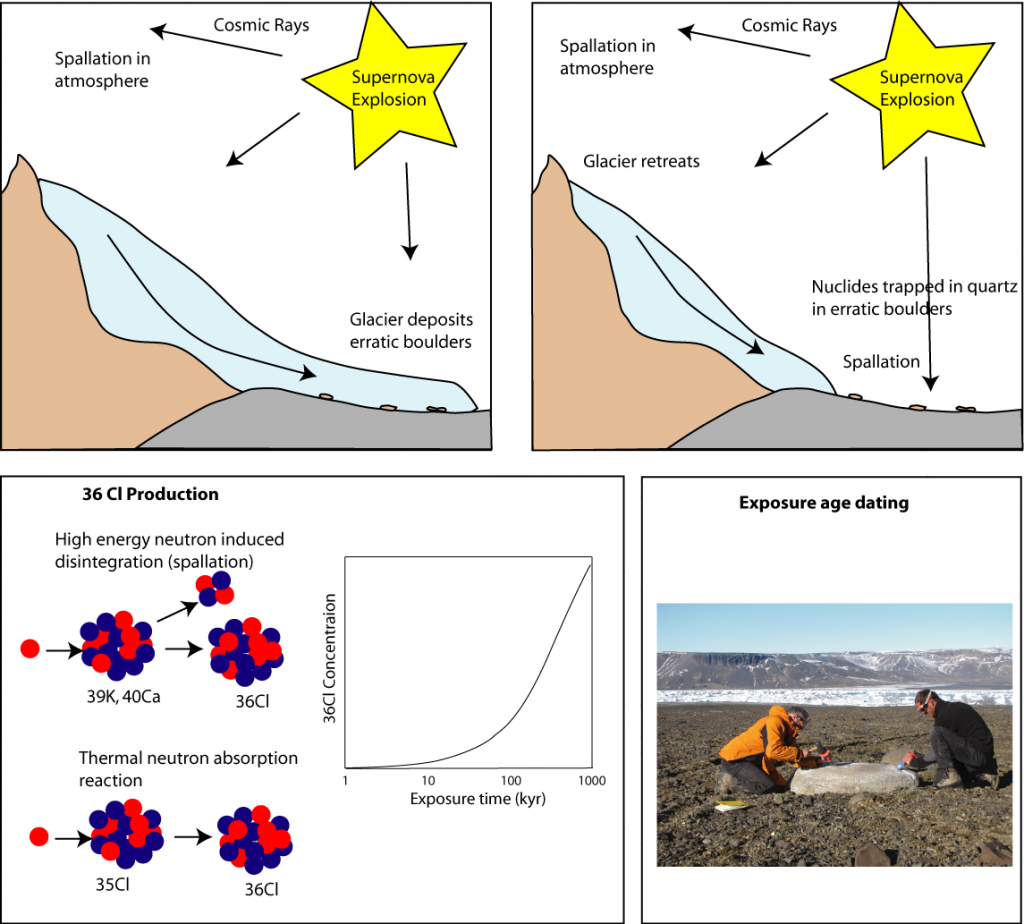
A glacier transports an erratic boulder, and then recedes, exposing it to cosmic rays. Spallation reactions occur in minerals in the rocks upon bombardment by cosmic rays. By sampling the rocks and separating certain minerals (such as quartz or pyroxene) and calculating the amount of these minerals (as a ratio to other, stable, minerals), we can work out how long the rock has been exposed on the earth’s surface.
These cosmic rays do not penetrate deep into the earth’s surface. This is important for glacial geologists, as it means that surfaces that have had repeated glaciations with repeated periods of exposure to cosmic rays can still be dated, as long as they have had sufficient glacial erosion to remove any inherited signal.
Using cosmogenic nuclides in glacial geology
Reconstructing past ice sheet extent
Glacial geologists use this phenomenon to date glacial landforms, such as erratics or glacially transported boulders on moraines[7] or glacially eroded bedrock. Dating glacial landforms helps scientists understand past ice-sheet extent and rates of ice-sheet recession.
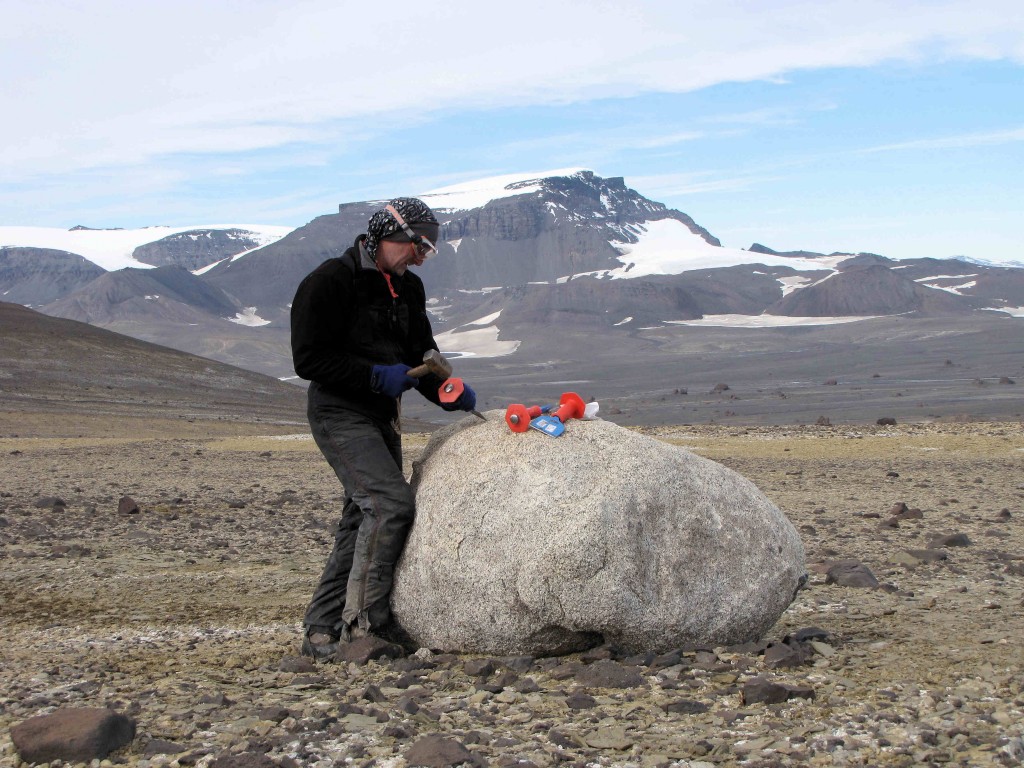
The basic principle states that a rock on a moraine originated from underneath the glacier, where it was plucked and then transported subglacially. When it reaches the terminus of the glacier, the boulder will be deposited. Glacial geologists are often interested in dating the maximum extents of glaciers or rates of recession, and so will look for boulders deposited on moraines.
Once exposed to the atmosphere, the boulder will begin to accumulate cosmogenic nuclides. Assuming that the boulder remains in a stable position, and does not roll or move after deposition, this boulder will give an excellent Exposure Age estimate for the moraine. The exposure age therefore provides an estimate of the length of time a rock surface has been exposed at the Earth’s surface.
Rates of ice-sheet thinning
As well as using cosmogenic nuclide dating to work out the past extent of ice sheets and the rate at which they shrank back, we can use it to work out ice-sheet thicknesses and rates of thinning[5, 6]. Sampling and dating boulders in a transect down a mountain will rapidly establish how thick your ice sheet was and how quickly it thinned during deglaciation.
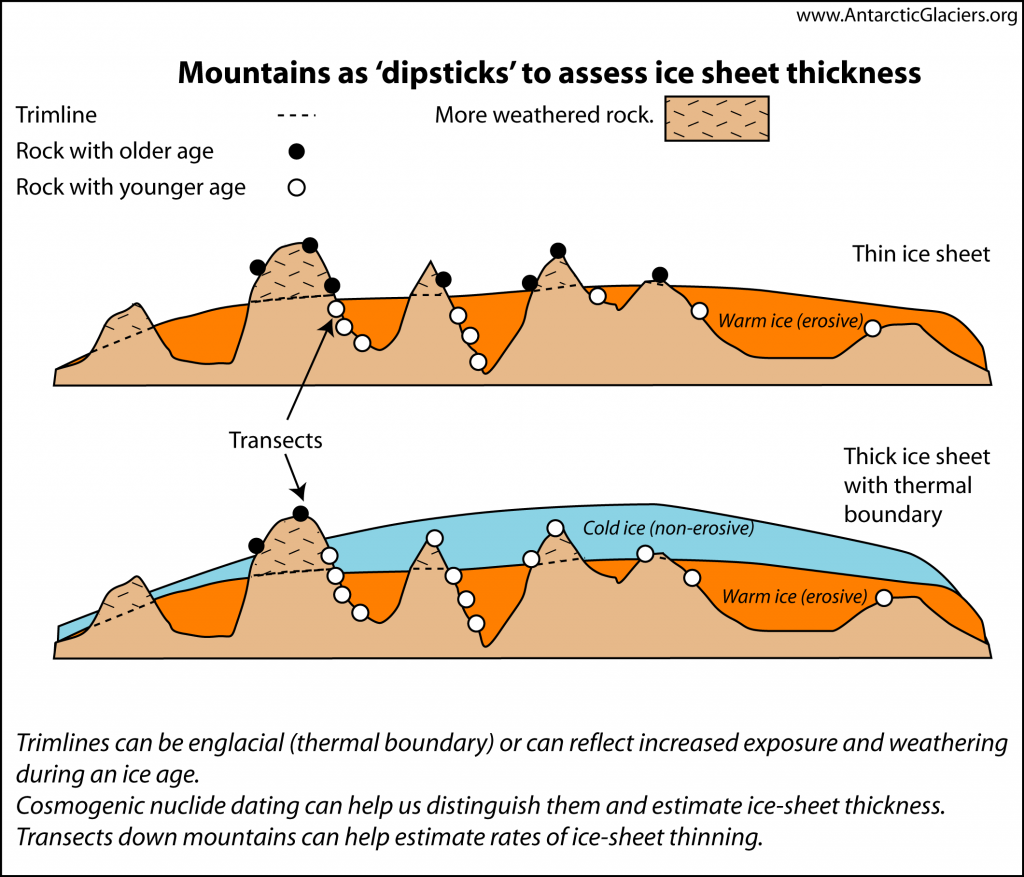
Many mountains have trimlines on them, and are smoothed and eroded below the trimline, and more weathered with more evidence of periglaciation above the trimline. Trimlines can therefore also be used to reconstruct past ice sheet thickness.
However, this can be difficult, as thermal boundaries within the ice sheet may mean that it is more erosive lower down than higher up, and that cold, non-erosive ice on the tops of mountains may leave in tact older landscapes. Cosmogenic nuclide dating can also be used in this context to understand past ice-sheet thicknesses and changes in subglacial thermal regime.
Sampling strategies cosmogenic nuclide dating
Sampling strategy is the most important factor in generating a reliable exposure age. Several factors can affect cosmogenic nuclide dating: rock type, attenuation of cosmic rays, topographic shielding, post-depositional movement, and burial and cover by snow, vegetation or earth.
Choosing the correct rock type
Geologists must ensure that they choose an appropriate rock. Granite and sandstone boulders are frequently used in cosmogenic nuclide dating, as they have large amounts of quartz, which yields Beryllium-10, a cosmogenic nuclide ideal for dating glacial fluctuations over Quaternary timescales.
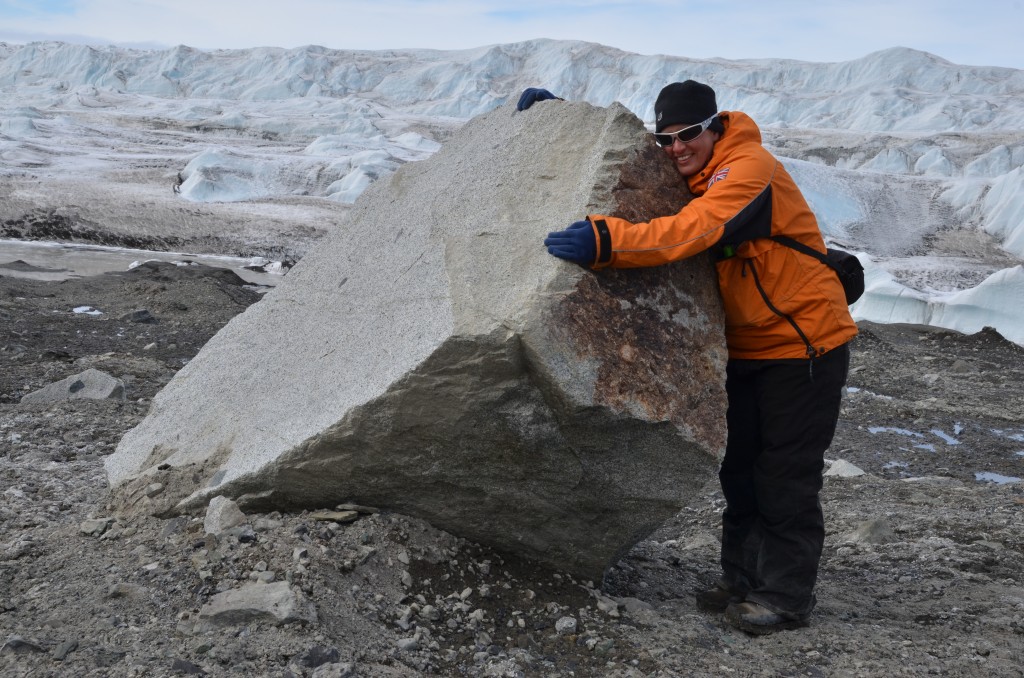
Beryllium-10 (10Be) does not occur naturally in quartz, and once it forms following spallation it becomes trapped by quartz’s regular crystal lattice.
For a rock to be suitable for cosmogenic nuclide dating, quartz must occur in the rock in sufficient quantities and in the sufficient size fraction. A general rule of thumb is that you should be able to see the quartz crystals with the naked eye.
Attenuation of cosmic rays
Because cosmic rays become attenuated with depth through the rock, scientists are only interested in collecting the upper few centimetres of a rock’s surface. Rock samples may be collected with a hammer and chisel or with a rock saw. This can take a very long time!
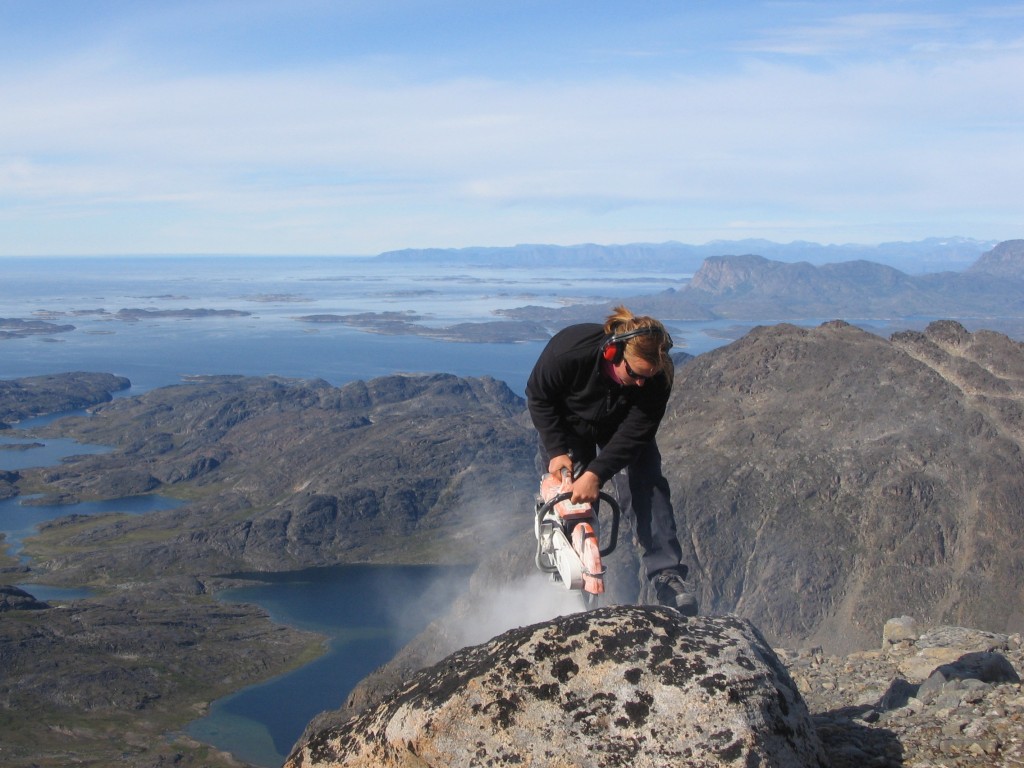
Stable position
One of the largest errors in cosmogenic nuclide dating comes from a poor sampling strategy. Because cosmic rays only penetrate the upper few centimetres of a rock, movement of a boulder downslope can result in large errors in the age calculated.
Before sampling a rock, geologists must take detailed and careful measurements of the landsurface, and satisfy themselves that the rock is in a stable position, has not rolled, slipped downslope, been repeatedly buried and exhumed during periglacial rock cycling within the active layer (frequently a problem with small boulders), and has not been covered with large amounts of soil, snow or vegetation.

Signs of subglacial transport
Geologists must also be sure that the rock has undergone sufficient glacial erosion to remove any rock that might have previously been exposed at the Earth’s surface, and so have accumulated cosmogenic nuclides.
They want to sample a rock that they are sure has undergone subglacial transport. They will therefore sample boulders that are subrounded, faceted, bear striations, or show other signs of subglacial transport.
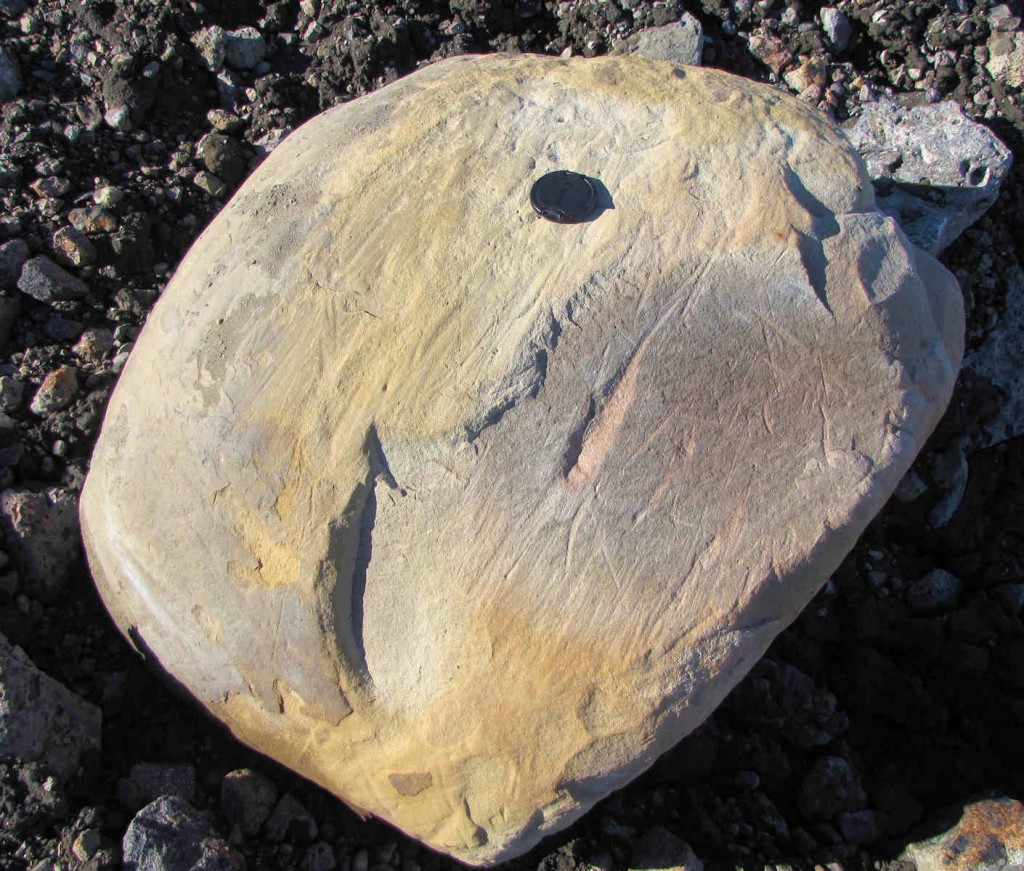
Accounting for variable production rates
Cosmogenic nuclide production rates vary according to latitude and elevation. These factors must be measured by the scientist, and are accounted for in the calculation of the exposure age.

Topographic shielding, for example by a nearby large mountain, also affects the production rate of cosmogenic nuclides. This is because the cosmic rays, which bombard Earth at a more or less equal rate from all sectors of the sky, will be reduced if the view of the sky is shielded – for example, by a large mountain that the rays cannot penetrate.
Scientists must therefore carefully measure the horizon line all for 360 degrees all around their boulder.
Difficulties in cosmogenic nuclide dating
As mentioned above, sampling strategy is the most import factor in generating a reliable cosmogenic nuclide age. Post-depositional processes, such as rolling, burial, exhumation or cover with vegetation can result in interruption of the accumulation of cosmogenic nuclides and a younger than expected age.
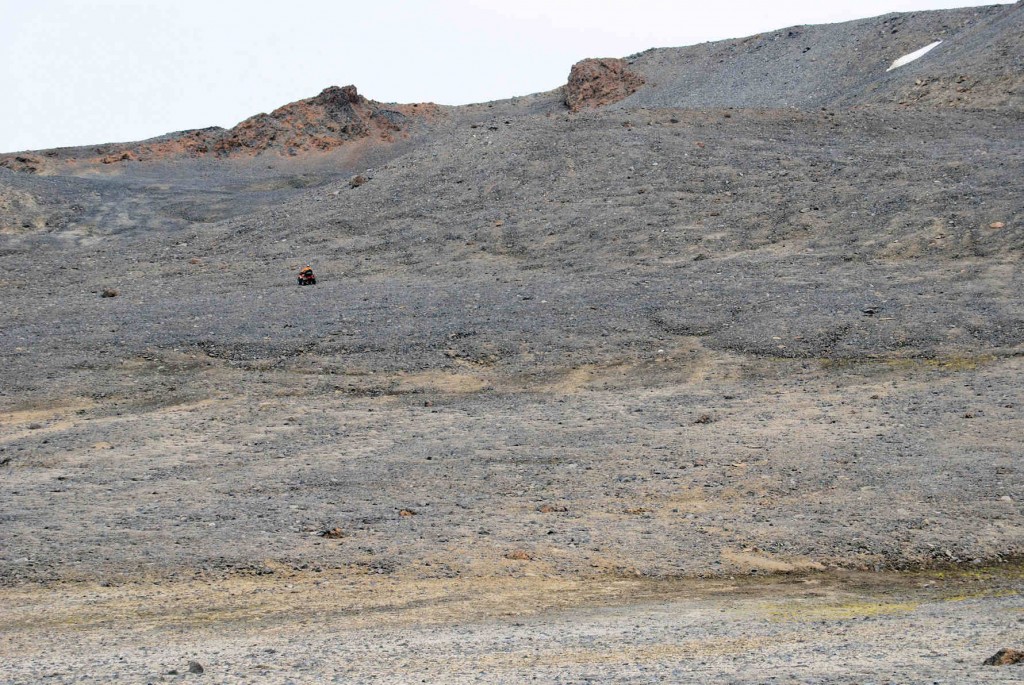
Alternatively, if the boulder has not undergone sufficient erosion to remove previously accumulated cosmogenic nuclides, it will have an older than expected age. This is called inheritance. This can be a particular problem in Antarctica, where cold-based ice may repeatedly cover a boulder, preventing the accumulation of cosmogenic nuclides, without eroding or even moving the rock.
Rocks can therefore be left in a stable position or moved slightly, without having suffiicient erosion to remove cosmogenic nuclides from a previous exposure. This can result in a complex exposure history. This is typically characterised by spread of exposure ages across a single landform.
Dating just one boulder from a moraine may therefore be an unreliable method to rely on. Scientists may also screen for complex exposure by using two different isotopes, such as aluminium and beryllium (26Al and 10Be).
Calculating an exposure age
Production of cosmogenic nuclides
The cosmogenic nuclide concentration in a rock is proportional to the length of time that it has been exposed on the earth’s surface[3]. The Production Rate of cosmogenic nuclides varies spatially, but is generally assumed to have remained constant at a particular location. Published production rates are available for different parts of the Earth.
Glacial geologists target elements that only occur in minerals in rocks, such as quartz, through cosmic-ray bombardment, such as aluminium and beryllium (26Al and 10Be). Beryillium-10 is used most widely, as it has the best determined production rate and can be measured at low concentrations[3]. Chlorine (36Cl) can also be used to date the exposure age of basalt lavas[4].
Extraction of quartz
The first stage in the calculation of a cosmogenic nuclide exposure age is to extract the quartz from a rock. This is quite an involved process and means using some quite dangerous chemicals, such as HF (Hydrogen Flouride). HF is an acid with a pH of about 3, but the small molecule is easily absorbed by your skin.
Once absorbed, it reacts vigorously with the calcium in your bones, forming Calcium Flouride which may then be deposited in your arteries. All in all, not a substance you want to get on your skin! Scientists must therefore take strong precautions before using this chemical.

The first stage is to crush the rock (or rock fragments) in a jaw crusher. The crusher must be perfectly clean to avoid contamination. The crushed rock is then sieved to the right size. Magnetic seperation removes particles with lots of iron (such as micas), leaving you (if you sampled granite, for example) with a 100 g sample of sand, comprising mostly feldspar and quartz.
Preparation for AMS measurement
Feldspar is removed by placing the sample in Hexafloursilicic acid or HF on a shaking table for around 2 weeks. The acids are changed daily. The more durable quartz is left behind. Atmospheric 10Be, which contaminates the sample, is removed by dissolving the outer third of the rock in 16% HF.
After testing the purity, the remaining quartz is dissolved in 40% HF (now it’s really time for the thick rubber gloves!). A series of chemical precipitations leaves you with Beryllium Oxide (BeO), a white powder. It is mixed with Niobium (NB) and pressed into a copper cathode. This is now ready to be analysed by the Accelerator Mass Spectrometer (AMS).
Calculation of an exposure age
Once the ratio of cosmogenic to naturally occuring isotopes has been calculated, the production rate is used to calculate an exposure age. This varies with altitude and latitude. Topographic shielding and shielding by snow, vegetation or soil is also taken into account. There are a number of online calculators that can be used to calculate the exposure age.
Further reading
The video below, produced by Science Bulletins, National Centre for Science Library, nicely and simply illustrates the core concepts in cosmogenic exposure age dating.
See also:

Something appears seriously wrong with this description:
By sampling the rocks and separating certain minerals (such as quartz or pyroxene) and calculating the amount of these minerals (as a ratio to other, stable, minerals), we can work out how long the rock has been exposed on the earth’s surface.
It’s isotopic measurements in mineral separates that are used for dating and not minerals
Many thanks for catching that glaring error! Updates to this particular page are in progress.
Right, I have now updated this page to a much more thorough description of CRN dating!
instead of using Hexa-flurosilicic acid for removing the feldspar we can use magnetic separator or isodynamic.
Hello Dr. Davies,
I’m Savio Antonio Vogt, an Experimental Nuclear Research Scholar from the department of Nuclear Physics, Andhra University. My dissertation focuses on Trace Element Analysis on the Quaternary Core Samples that I have extracted from the Krishna-Delta, Andhra Pradesh.
I want to thank you for this article as it interests me very much. For further analysis I plan to subject my samples to more a highly sensitive analysis, the Accelerator Mass Spectrometry to find out the Be conc. present in these Cores.
Do professionally keep in-touch.
Hello, I’m looking some geological method (if there is) for dating old man made holes (archelogical ones) on effusive igneus rocks in Italy. Thanks…
I have an archaeological site in California composed of large boulders of Tonolite. The boulders make up a line of rocks several hundred meters long. Historians and archaeologists have ignored the rock line and assumed it is the remnant of a stone wall built by 19th century farmers. The problem with this assumption is that there is no written record of any kind describing the construction of this wall. The oldest map that might show the stone line is from 1853. The coastal Mewok have a name for the line in their oral history, “Spirit of Jumping Off Rocks”. And, some of the boulders that make up the “wall” are very large (approximately 2 meters long, 1 meter wide and at least 1 meter thick). Why a farmer would use such large rocks is unknown. As far as anyone knows these rocks have been exposed ever since they were placed. Can cosmogenic surface dating be applied to these rocks? Is there a lab that does this work? How much does it cost?
Tonolite contains quartz so theoretically you could use cosmogenic isotope dating. It does require removing a sample, so it would require permenantly altering the rocks, which is worth considering.
I am not aware of commercial labs doing cosmogenic dating, however there are a number cosmogenic isotope processing labs in Universities or research establishments in the UK and Europe, as well as the US. I have not used Be10 dating (the method you could use), however sample preperation is expensive material wise, and is a time consuming process which requires expertise and specialised environments in which to process the samples. I would not be suprised if the cost of running a reasonable number of samples runs into thousands of dollars (at least).
As pointed out in the above article, selecting an appropriate sample is key, so having someone who knows what they are doing come and sample the site would be vital, and another cost consideration.
Optically stimulated luminescence dating may be another avenue to explore, but I have less knowledge of this area.